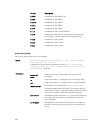
NOTE: When you specify a single VRF, use the name of
the VRF instead of the VRF ID number. Use the VRF ID
numbers only when you specify a range of VRFs.
Defaults Not enabled.
Command
Modes
INTERFACE/VRF MODE
Command
History
This guide is platform-specific. For command information about other platforms,
refer to the relevant Dell Networking OS Command Line Reference Guide.
The following is a list of the Dell Networking OS version history for this command.
Version Description
9.7(0.0) Introduced on the S6000–ON.
9.4.(0.0) Added support for VRF.
9.0.2.0 Introduced on the S6000.
8.3.19.0 Introduced on the S4820T.
8.3.11.1 Introduced on the Z9000.
8.3.7.0 Introduced on the S4810.
8.1.1.0 Introduced on the E-Series ExaScale.
7.8.1.0 Increased the name string to accept up to 140 characters.
Prior to 7.8.1.0, names were up to 16 characters long.
7.6.1.0 Introduced on the S-Series.
7.5.1.0 Introduced on the C-Series.
6.2.1.1 Introduced on the E-Series.
Usage
Information
You can assign one ACL (standard or extended ACL) to an interface.
NOTE: This command supports Loopback interfaces EE3 and EF series route
processor modules (RPMs). This command does not support Loopback
interfaces ED series RPMs and S-Series Loopback interfaces.
NOTE: If you apply outbound(egress) IP acl on a switch port, the filter applies
only for routed traffic egressing out of that port.
To associate an access-list to a non-default VRF, use the vrf attribute of this
command. You can use this command at the interface context (physical/LAG) to
apply the access-list to a range of VRFs.
The VRF MODE is not available for the default and management VRFs.
Related
Commands
ip access-list standard — configures a standard ACL.
Access Control Lists (ACL)
227


















